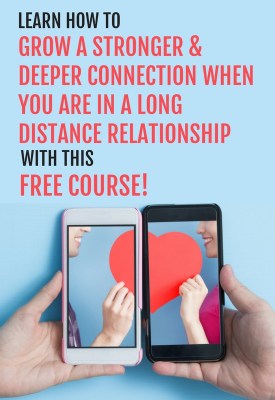
By: Jennifer Belus. Jennifer has a PhD in Clinical Psychology and works as a researcher at the University of Maryland. Her research is focused on developing interventions to help couples overcome mental and physical health problems and relationship challenges. She is also co-creator of Elevate Wellness Retreats, a weekend retreat focused on helping couples get healthier together. Find out more about her work here.
So you’re in a long-distance relationship (LDR)? Maybe you
or your partner took a job or educational opportunity in another city, state,
or country. Maybe one (or both) of you is currently deployed. Or maybe you met
while living in separate locations and have each stayed in your respective
cities. Whatever the reason, couples in LDRs know that maintaining a healthy
relationship at a distance takes work! Of course every relationship requires
effort, but LDRs have unique challenges to maintaining good relationship
health.
Two major challenges in LDRs are how to maintain daily
communication and a sense of closeness and intimacy when you’re physically
separated most of the time. Maintaining that connection is more challenging
when you’re long-distance, since some of the ways you might show closeness or
experience intimacy you can’t do when far apart—a quick kiss, a light touch, or
even eye contact.
Of course, it is very possible to feel connected to your
partner while being geographically separated; the trick is to know what to do
and when to do it, in order to maximize intimacy and closeness. Continue
reading to find out more about what’s important.
One Way to Think about
an LDR
Instead of thinking of your entire relationship as one big separation, it can be helpful to think about periods of separation (when you and your partner are physically apart for longer stretches of time). Each of these periods of separation also has a before and after. Let’s break this down.
Before separation. This is the time when you and your partner are together, but you’re anticipating the upcoming separation. Like the Monday morning after you’ve spent the long weekend together and one of you is driving or flying home later that day.
During separation. This is the long-distance part—where you are your partner are physically separated.
After separation. This is the period of time when you and your partner are physically reunited. For some couples this is one weekend at a time, whereas other couples might reunite for a month or longer, but then have longer periods of separation in between.
This before, during, and after separation is a cycle—you’re
physically together, then you separate, and then finally (after what might feel
like forever) you reunite. This cycle continues for as long as you’re in an
LDR. So why is thinking about LDRs in this way helpful?
The most important reason for breaking down LDRs in this way is that what you do to maintain a healthy relationship looks different in each phase. A lot of what is written about LDRs focuses on the phase of separation. Now of course this is important—being physically separated is probably most of how you spend your time (physically apart, instead of together). But the other phases are important to think about too. So let’s talk about what’s helpful, and what isn’t, in each of these time phases.
Before we talk about what to do in each phase, have you ever thought about your own LDR in this way before?
How do ‘I’ and ‘They’
Fit into ‘Us’?
Before we dive into what to do, and what not to do, in each
phase of the LDR, I want you to consider one more thing. If you read much about
LDRs—seeking advice or tips on how to best manage your relationship at a
distance—then you probably read a lot about what you and your partner, together, ought to be doing. Like
communicating often. Spending a certain amount of time together. It makes sense
to focus on the relational aspect, but it’s not the only piece.
What you each do individually,
your own thoughts and behaviors, and how you each incorporate your broader social network, like leaning on family
or friends for support, has an impact.
There are actually three dimensions to how you
maintain your relationship—what each partner does on their own (individual
dimension), what the couple does together (relational dimension), and how each
partner brings in their broader social network (network dimension).
Before you read on, have you considered the individual and network dimensions of how you approach your LDR?
Different Ways of
Maintaining your Relationship at a Distance—All are Not Created Equal
If we put together the LDR phases (before, during, and after separation) with the dimensions of relationship maintenance (individual, relational, and network), we end up with a 3 x 3, like this one (click to download a PDF outlining the three angles we can use to consider an LDR). When we look at it like this, it helps us see that the strategies we use at each phase and at each dimension can look different. These strategies then have the potential to work more or less well, depending on the phase and the dimension.
You might be wondering, “So which ones are good? Which ones
should I focus my energy on?” Lucky for you, we did a survey study on this with
US adults in LDRs that can shed some light.
The Role of the
Couple
The first not too surprising finding was that the relational
dimension (what the couple does together) during the separation phase was
important for overall relationship well-being. Individuals who communicated
more with their partners during their time apart reported greater relationship
satisfaction.
However, what the couple did before or after separation did
not predict someone’s reported level of relationship satisfaction.
The take home point
here is that what you do as a couple while you’re physically apart seems
to be most important for relationship well-being. Focus less on what
exactly you’re going to do when you’re reunited and spend more time figuring
out how to communicate with each other regularly while you’re apart to maintain
that connection. For some couples that includes frequent texts throughout the
day and short call at night. For other couples it’s a long catch up on video
chat in the evening but very little throughout the day. You and your partner
need to figure out what works for you, as a unit.
The Role of the
Individual
Now, the more surprising findings. When we looked at the
individual dimension of relationship maintenance—each person’s thoughts and
behaviors outside of what they do with their partner—we found that individual
behaviors before, during, and after separation were all related to relationship
satisfaction—but in different ways. More individually-focused behaviors before and
during separation (e.g., mentally preparing for the separation, reflecting on
the relationship during the actual separation), were related to more
relationship satisfaction.
In other words,
people who engaged in more mental preparation and personal reflection in
advance of the physical separation, and then again while they were physically
separated from their partner, were more satisfied with their relationship.
This highlights that what you do on your own is important for your
relationship health—not just what you and your partner do together.
What you do on your own is important for your relationship health—not just what you and your partner do together.
Jennifer Belus
Even if you’ve been in an LDR for a while, and feel like you’ve gotten into a rhythm with the separating and reuniting, the process can still take a toll, physically and emotionally. Taking the time to plan for the separation and get into the right ‘head space’ can help with the transition.
It also helps that when separated from your partner, you
continue to engage in positive beliefs about your relationship. Of course, if
you’re really struggling in the relationship, just thinking positively is not
going to solve the underlying problem. But it can be helpful to keep positive future-oriented
thoughts on hand as a relationship tool, like reminding yourself that your
relationship can withstand the distance.
And when you’re missing your partner during the separation, you can also do some independent reminiscing. Thinking back to previous good times in the relationship can be satisfying and continue to strengthen the connection you have with your partner, even when the two of you are not together. (Here are some other ways to help yourself become happier and healthier while you’re apart.)
Although these more individually-focused behaviors before and during separation appear quite helpful, in our study, the use of these behaviors during the time when the couple was reunited was related to lower relationship satisfaction. Things like processing the recent separation on your own when you and your partner have already reunited is likely unhelpful because it pulls you away from spending time with your partner and building new connections.
The Role of the
Network
And what about the role of the network in relationship
maintenance? It turns out, those behaviors don’t matter too much. Whether you
like to share a little, or a lot, with friends or family about your
relationship, it doesn’t seem to have an effect on how satisfied you are with
your relationship.
Bottom Line
Here are the top three take-home points from this research study and some action items for you to consider:
1. How often you and your partner communicate during the period of being physically separated was associated with relationship satisfaction—more communication was associated with greater relationship satisfaction.
Each time you and your partner communicate, it gives you an opportunity to develop a new, deeper connection.
Action item: Reflect on how often you and your partner communicate during your time apart.
When you do communicate, regardless of the mode (text, phone call, video chat) are you and your partner using communication as an opportunity to build new connections with each other? If not, consider changing up when or how you communicate as a first step.
You also may have gotten into a rut with what you talk about. Experiment with video date nights or exploring new topics of conversation as a way to have fun and get to see each other in a different light.
2. What you do on your own (your own thoughts and actions) before and during separation is just as important for your relationship satisfaction as what you and your partner do as a couple.
Getting into the right ‘head space’ before you and your partner separate can help ease the transition of flying solo again. Once separated, you can use that solo time to continue to feel closer to your partner by actively reflecting on past positive relationship experiences (like that great vacation you took together last summer) and also continuing to have positive future-oriented thoughts about your relationship (“Our relationship can withstand the distance”).
Action item: What kind of thoughts do you tend to have before and during physical separation from your partner? If they’re mostly negative, try starting by intentionally reflecting on a positive memory. It’s also okay if some feelings of sadness/longing come up while you’re reflecting—that just means you care about your partner and value the relationship.
3. In our study, greater relationship satisfaction also predicted greater personal well-being.
People who reported higher relationship satisfaction also reported less psychological distress (less depression, anxiety) and overall more satisfaction with life. The benefit then of enhancing your relationship is that there’s also a good chance you’ll improve your own well-being in the process.
Action item: Reflect on how your emotional well-being is connected to your relationship satisfaction. Notice how you feel at times when your relationship is thriving and times when you and your partner might be struggling. If you notice that these two go hand-in-hand for you, then all the more reason to find ways to prioritize your relationship health. Start by incorporating the relationship action items discussed above and see how that might shift your emotional well-being.
Food for Thought
What individual, relational, or network behaviors do you engage in before, during, and after separation?
Use the chart provided to identify which behaviors you (and your partner) are currently doing. Are you spending enough energy and time on the behaviors that count most (individual behaviors before and during separation and the relationship behaviors during separation)?
Share this Post













Recent Comments